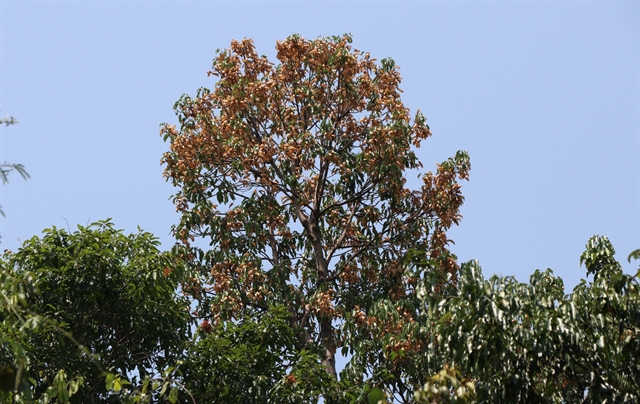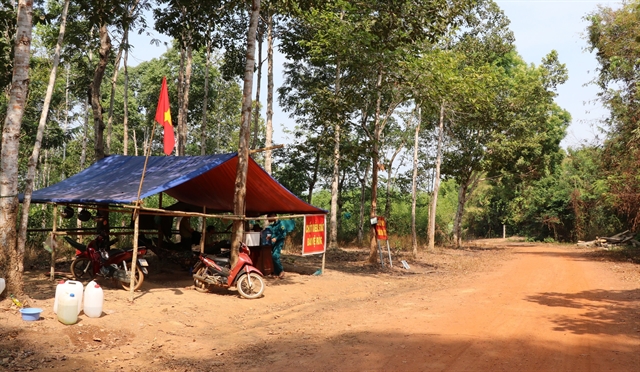 Society
Society

 |
| Malva trees with ripe nuts in Vĩnh An forest in the Đồng Nai Culture and Nature Reserve. The nut's skin turns from green to brown when ripe. — VNA/VNS Photo Sỹ Tuyên |
ĐỒNG NAI — Forest rangers in the Đồng Nai Culture and Nature Reserve in Đồng Nai Province are stepping up efforts to protect malva nut trees from illegal harvesting as they are now in their harvest season.
The reserve encompasses over 100,000ha, including 30,000ha where about 7,300 malva nut trees with diameters of at least 40cm grow.
They are found in the Vĩnh An, Hiếu Liêm and Mã Đà forests in Vĩnh Cửu District.
Malva nuts have significant economic value, which attracts illegal logging by people living in the reserve's buffer zones. This can damage the trees and increase the risk of forest fires during the dry season.
A malva nut tree begins to flower and bear fruit when it is 15-20 years old. The nuts are primarily used to make beverages and have medicinal benefits like detoxification and boosting the immune system.
Võ Quang Trung, deputy head of the reserve’s nature preservation and co-operation division, said: “When people enter forests illegally to harvest malva nuts, they might cut down a malva nut tree to collect the nuts, destroying the tree. If they cut branches to harvest the nuts, it takes the tree four to five years to recover and bear fruit again.”
The reserve expects a bountiful harvest of malva nuts this year because trees have many flowers and fruits, with the ongoing dry season providing extended heat without unseasonable rains, ideal conditions for a bumper crop.
Lê Văn Gọi, deputy director of the provincial Department of Agriculture and Rural Development, noted that every three to four years there is typically a bumper harvest of malva nuts, usually in a year with particularly hot and dry weather during the dry season.
This poses risks for forest management, protection and fire prevention as more people may enter the forests illegally to harvest the nuts, according to Gọi.
Forest owners are urged to implement robust protection measures. However, the vast area of the reserve complicates this task, the reserve’s Forest Protection Division admitted.
It has four forest protection stations in Phủ Lý Commune, which has a high concentration of malva nut trees.
Earlier this year the division formulated plans to protect malva nut trees, Trương Đình Minh, deputy head of the division said.
According to Phan Huy Vĩnh, deputy head of the Đa Kinde forest protection station in Phủ Lý, this station has seven personnel managing nearly 6,000ha of forests and over 1,000 malva nut trees with diameters exceeding 40cm.
"The malva nut harvest season occurs during the dry season, which is also when rangers have many other tasks such as preventing poaching and monitoring forest fires. Thus, we have to work twice as hard to meet our responsibilities."
The division has mobile units to monitor forest areas bordering Bình Phước Province, where there's a high risk of illegal harvesting of malva nuts.
It also has rangers joining the mobile patrol groups of the Vĩnh Cửu District Steering Committee for the sustainable forestry development programme.
It cooperates with neighbouring forest protection units, including those of the Cát Tiên National Park and Bình Phước Province’s Bù Đăng Protective Forest, and forest protection bureaux in adjacent districts in Bình Phước and Bình Dương provinces.
 |
| A forest protection station in Suối Kốp forest in the Đồng Nai Culture and Nature Reserve. It has personnel from various agencies, including rangers from the reserve and Vĩnh Cửu District and the police, to prevent illegal entry into the forest during the ongoing dry season. — VNA/VNS Photo Sỹ Tuyên |
Minh said the reserve, in cooperation with local authorities, had raised awareness to discourage people from illegally harvesting malva nuts.
“We have strictly implemented protection plans for malva nut trees from the outset, which helps reduce illegal entry and potential damage to the forests." — VNS